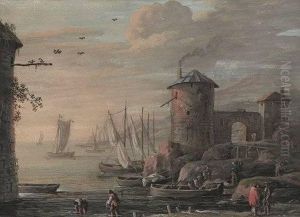Johann Siegmund Dietzsch Paintings
Johann Siegmund Dietzsch was a German painter and engraver born in 1702 in Nuremberg, a city renowned for its artistic and cultural activities during the 17th and 18th centuries. He was part of a family of artists, with his father, Johann Israel Dietzsch, being a painter and his siblings, Barbara Regina and Johann Daniel, also pursuing careers in the arts. The Dietzsch family contributed significantly to the art scene in Nuremberg, with their work characterised by the baroque style prevalent during that period.
Johann Siegmund Dietzsch specialized in watercolor and gouache paintings, often focusing on landscapes, botanical illustrations, and still lifes. His approach combined a keen observation of nature with a delicate touch, enabling him to create detailed and vibrant representations of the natural world. His landscapes often depicted the idyllic countryside around Nuremberg and are notable for their serene atmosphere and the use of light.
Despite the quality of his work, Johann Siegmund Dietzsch did not achieve the same level of fame as some of his contemporaries. However, he was esteemed in his hometown and his works were collected by local patrons. His engravings and paintings were typical of the period's aesthetic and contributed to the visual documentation of the flora and landscapes of his region.
Dietzsch's legacy is maintained by the works that survive him and the influence he had on the artistic community in Nuremberg. He died in 1770, leaving behind a body of work that, while not widely known outside of Germany, is appreciated for its contribution to the baroque and rococo movements in German art history.
